For India, one of the major challenges in the coming years will be improving the quality of food colour for both domestic and international consumption. Food colour suppliers will play a major part in the sustenance of India’s flourishing food industry. Because of the increasing demand for natural food color, organic food colour as and green formulations, food color suppliers in India need to shift focus toward more sustainable options that are also health conscious.
Types of Food Colour Available in India
- Synthetic food colours – Popular for their price and sameness, these are extensively used in drinks and sweets.
- Natural food colour – Gaining acceptance worldwide, this is extracted from various plants and fruits and is much safer for health.
- Organic food colour – These for the premium health market are certified as chemical-free.
- Food colour powder – A form that has great ease of use along with a long shelf life suits large-scale food processing.
This extensive choice of options is what gives Indian food color manufacturers an edge over their competitors worldwide.
Leading food coloring manufacturers in India
The food color manufacturers in India are some of the most respected all around the world and meet requirements like FSSAI, ISO, and FDA. They manufacture numerous synthetic food colors and natural food colour for different sectors, such as baking, dairy, beverages, and even pharmaceutical industries.
Some of them are well known as natural food color exporters in India, offering services to more than a hundred nations.
Sourcing the Right Food Colour Suppliers
Finding the right supplier is crucial for maintaining consistent quality, price competitiveness, and compliance with export regulations. A strategic sourcing approach helps build long-term success in the food industry.
How to Identify the Right Suppliers
Finding qualified food colour suppliers
Identifying reputable food colour suppliers requires careful consideration of several issues:
- Available products (liquid, gel, food colour powder)
- Terms of Contract (T&C) for buyers and T&C for sellers
- Accreditations (FSSAI, Halal, and Organic)
- Dependence on supply and response time for the order
- Price of food color powder price
Many buyers meet suppliers via online B2B sites, food exhibitions, and trade boards announced by the government.
Natural and Organic Food Colouring Trends
The growing consciousness about healthy living has caused a major change in the preference for natural food color and organic food colour. Using natural food colouring powder made from turmeric, beetroot, spinach, and red cabbage is increasingly popular for both the local and international markets.
These clean-label solutions match the patterns observed in other natural exports, such as the Jaggery Export from India, which is primarily focused on purity and wellness marketing.
Food Color Powder Price & Market Insights
The food color powder price in India is contingent on the origin (natural or synthetic), quality tier, and relevant issued documents. Generally, natural food colors, and especially organic food colors, sell for much higher prices due to the elaborate extraction methods, while synthetic ones are sold at reasonable prices.
Given the increasing adoption of certified natural colors coupled with the expansion in global demand and the expected regulatory approvals, prices are likely to increase in a steady fashion come 2025.
Export Opportunities for Indian Food Colour
With the growing popularity of India’s natural food colors, Indian food colour manufacturers are exporting to new markets. Some of the countries include the USA, UK, UAE, and the Southeast Asian Nations, which are some of the primary target markets for India’s natural food color exporters.
This corresponds with the complete export scenario of India as elaborated in A Comprehensive Guide to Spices Export from India: Key Markets and Trends, where food ingredients are one of the leading sectors along with spices.
Challenges in Sourcing Food Colour
While the food colour industry in India is growing, sourcing challenges still exist that can affect the consistency, availability, and global compliance of the final product.
Key Issues in the Supply Chain
Even with the rising demand, problems persist:
– Getting consistent curcumin or pigment concentration
– Package safety and shelf life
– Marked export constraints
– Supply of raw materials determining the food color powder price
These problems can be effectively solved with appropriate, quality-centric sourcing.
Future of Food Colour Industry in India (2025 and Beyond)
As far as the future is concerned, the food colour industry will blossom with new opportunities in India. There will be heightened interest in natural food color, organic food colour and clean label food products as food color users. Manufacturers are allocating more funds for R&D towards plant-based pigments and eco-friendly nonplastic containers.
food colour suppliers will contribute significantly to India’s developing food ingredient exportation business as the country enhances its reputation for being a global supplier.
Conclusion
The food color industry in India is multifaceted, from synthetic food colors to natural food colouring powder. We recommend businesses contact reliable food colour suppliers and food colour manufacturers to ensure consistency, affordability, and international standards.
If you work in or export products, looking into Indian partners might be the breakthrough you needed for 2025.

